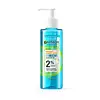What's inside
What's inside
 Key Ingredients
Key Ingredients

 Benefits
Benefits

 Concerns
Concerns

No concerns
 Ingredients Side-by-side
Ingredients Side-by-side

Water
Skin ConditioningSodium Laureth Sulfate
CleansingGlycerin
HumectantDecyl Glucoside
CleansingSodium Chloride
MaskingCoco-Betaine
CleansingSalicylic Acid
MaskingPEG-150 Pentaerythrityl Tetrastearate
EmulsifyingParfum
MaskingCitric Acid
BufferingHexylene Glycol
EmulsifyingPEG-6 Caprylic/Capric Glycerides
EmulsifyingTetrasodium Glutamate Diacetate
Zinc PCA
HumectantCitrus Limon Fruit Extract
MaskingCapryloyl Salicylic Acid
ExfoliatingLinalool
PerfumingBenzyl Salicylate
PerfumingLimonene
PerfumingAscorbyl Glucoside
AntioxidantBenzyl Alcohol
PerfumingWater, Sodium Laureth Sulfate, Glycerin, Decyl Glucoside, Sodium Chloride, Coco-Betaine, Salicylic Acid, PEG-150 Pentaerythrityl Tetrastearate, Parfum, Citric Acid, Hexylene Glycol, PEG-6 Caprylic/Capric Glycerides, Tetrasodium Glutamate Diacetate, Zinc PCA, Citrus Limon Fruit Extract, Capryloyl Salicylic Acid, Linalool, Benzyl Salicylate, Limonene, Ascorbyl Glucoside, Benzyl Alcohol
Water
Skin ConditioningDecyl Glucoside
CleansingXanthan Gum
EmulsifyingBambusa Arundinacea Stem Extract
Skin ConditioningCanarium Luzonicum Gum Nonvolatiles
MaskingCitrus Aurantium Dulcis Peel Oil
MaskingLuffa Cylindrica Fruit Powder
AbrasiveCoco-Glucoside
CleansingGlyceryl Oleate
EmollientHydrogenated Palm Glycerides Citrate
EmollientTocopherol
AntioxidantCitric Acid
BufferingGluconolactone
Skin ConditioningCalcium Gluconate
HumectantCI 77288
Cosmetic ColorantSodium Benzoate
MaskingWater, Decyl Glucoside, Xanthan Gum, Bambusa Arundinacea Stem Extract, Canarium Luzonicum Gum Nonvolatiles, Citrus Aurantium Dulcis Peel Oil, Luffa Cylindrica Fruit Powder, Coco-Glucoside, Glyceryl Oleate, Hydrogenated Palm Glycerides Citrate, Tocopherol, Citric Acid, Gluconolactone, Calcium Gluconate, CI 77288, Sodium Benzoate
 Reviews
Reviews

Ingredients Explained
These ingredients are found in both products.
Ingredients higher up in an ingredient list are typically present in a larger amount.
Citric Acid is an alpha hydroxy acid (AHA) naturally found in citrus fruits like oranges, lemons, and limes.
Like other AHAs, citric acid can exfoliate skin by breaking down the bonds that hold dead skin cells together. This helps reveal smoother and brighter skin underneath.
However, this exfoliating effect only happens at high concentrations (20%) which can be hard to find in cosmetic products.
Due to this, citric acid is usually included in small amounts as a pH adjuster. This helps keep products slightly more acidic and compatible with skin's natural pH.
In skincare formulas, citric acid can:
While it can provide some skin benefits, research shows lactic acid and glycolic acid are generally more effective and less irritating exfoliants.
Most citric acid used in skincare today is made by fermenting sugars (usually from molasses). This synthetic version is identical to the natural citrus form but easier to stabilize and use in formulations.
Read more about some other popular AHA's here:
Learn more about Citric AcidDecyl Glucoside is a glucose-based surfactant and emulsion stabilizer. It is created by reacting glucose with the fatty acids from plants.
Surfactants help clean the skin by trapping oil, sebum, and dirt to be washed away. As an emulsion stabilizer, it stabilizes the ingredients in a product by preventing them from separating.
This ingredient is biodegradable and non-toxic. This ingredient is commonly found in baby shampoos.
Decyl Glucoside is sometimes used to stabilize the UV filter Tinosorb.
Learn more about Decyl GlucosideWater. It's the most common cosmetic ingredient of all. You'll usually see it at the top of ingredient lists, meaning that it makes up the largest part of the product.
So why is it so popular? Water most often acts as a solvent - this means that it helps dissolve other ingredients into the formulation.
You'll also recognize water as that liquid we all need to stay alive. If you see this, drink a glass of water. Stay hydrated!
Learn more about Water